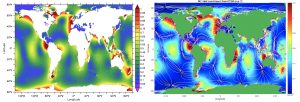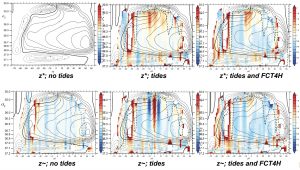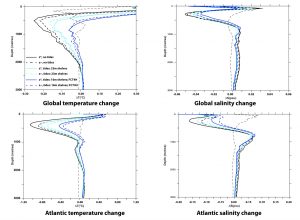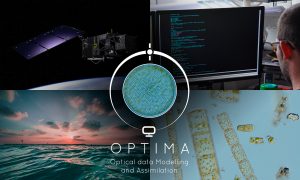REDUCING NUMERICAL MIXING RESULTING FROM APPLYING TIDES EXPLICITLY IN A GLOBAL OCEAN MODEL
PI and organization: A. Megann (NOC)
Co-Is: M. Luneva (NOC)
Objectives
Objective 1: To add explicit tidal forcing to the GO8.0 global ¼° NEMO configuration and evaluate the effects on water mass characteristics and mixing.
Objective 2: To add the z-tilde flexible vertical coordinate to this configuration and evaluate the effects on water mass characteristics and mixing, in particular to assess its effect in ameliorating numerical mixing from tidal and other high frequency motions.
Objective 3: To investigate the effects of tides on large scale ocean circulation including global stratification, the overturning and gyre circulations, shelf slope exchange, seasonal mixed layers, deep and bottom waters, and polar sea ice.
Achievements
The effects of tidal motions in global ocean models and coupled climate models have tended to be represented up to now by modifications to the mixing scheme to parameterise the mixing effect of barotropic and internal tides, rather than by explicit tidal forcing. This means that the local effects of tides in mixing and of tracer transports in such models has yet to be assessed. This project includes the first investigation of the effects of including tidal forcing in a global NEMO of eddy-permitting resolution.
With the default fixed vertical coordinate (z*) in the NEMO model, internal waves and internal tides are represented by vertical advective velocities, and truncation errors in the advection scheme have been shown to lead to significant levels of spurious numerical mixing in a global ¼° configuration, along with resultant drifts in temperature and salinity away from the initial climatological values. The z~ (“z-tilde”) vertical coordinate is a modification to the model in which the depth of the vertical levels is allowed to vary on time scales up to a few days, and this is intended to reduce the numerical mixing from this source. The model configuration created for RENUMERATE is the first implementation of z~ in a global model with realistic bathymetry, and so it was not known in advance whether this would prove to be stable, nor had its effects on numerical mixing in a global configuration been assessed.
Results
We carried a set of 30-year integrations with and without tidal forcing and with both z* and z~ vertical coordinates. A further pair of experiments was performed with both tidal forcing and the horizontal tracer advection increased from 2nd to 4th order, which has already been found to reduce the contribution to numerical mixing from poorly resolved mesoscale features. These confirmed first of all that both tidal forcing and z~ could be used in a global ¼° model at the standard 15-minute timestep.
Preliminary assessment of the tidal amplitudes (Figure 1) suggests that the barotropic tide is realistic in its spatial pattern, although a full harmonic analysis of the all the experiments has yet to be carried out, so this a like-for-like comparison is not yet possible. At this resolution, only the first internal tidal mode is present, and amplitudes are relatively weak compared with those of observed internal tides, so these are unlikely to contribute much to mixing. However, we have confirmed that the process of internal tide generation is resolved at least partially by the model, and further analysis of the propagation of internal tides should prove interesting.
Figure 1. RMS hourly surface elevation excursion from the mean (metres) over three months in tidal z* simulation (left) and M2 amplitude in GTSM reanalysis (right).
Figure 2. Ratio of zonally-averaged effective diffusivity keff to that in control, as a function of latitude and potential density s2. The contours are of the overturning streamfunction in sverdrups, and the bold dashed lines show the maximum surface density over the mean annual cycle. Blue shading shows a decrease in diffusivity; red and orange shades correspond to increased values.
Figure 2 shows that adding tides alone (top centre panel) gives increased mixing, diagnosed from the effective diapycnal diffusivity keff, (Megann, 2018). Adding either z~ or higher-order horizontal advection (“FCT4H”) reduces the effect of tides on the spurious numerical mixing, while in combination (lower right panel) these two changes reduce the numerical mixing in the tidally-forced model to below that in the non-tidal control. Perhaps surprisingly, tidal forcing actually reduces the rates of globally averaged temperature and salinity drifts (Figure 3), while z~ and more accurate tracer advection further reduce these drifts, although the substantial warm bias at 200-500m (occurring mainly in the Southern Ocean) in all of the experiments is not ameliorated by these changes.
Increasing the cutoff time for z~ from 5 days to 10 or 20 days (not shown here) appears to give promising further improvements, but the wider effects, including potentially worse pressure gradient errors, are still being investigated.
Figure 3. Temperature and salinity changes between 1976 and 2005 in the global and Atlantic domains, with the corresponding profile in the EN4 climatology (thin dashed black line).
Relevance to CMEMS programme
The project has implemented and tested recent developments in in a global configuration of the NEMO ocean model, specifically the tidal forcing and the z-tilde coordinate, that are of clear relevance to other configurations of this model. The fact that CMEMS operational systems use NEMO as their ocean model means that the evaluation of the model improvements will therefore feed promptly into research activities at CMEMS centres with benefits to the whole modelling and forecasting community. RENUMERATE will result in a step change to the current global ocean modelling capability with a realistic representation of a key missing process.
Recommendations for CMEMS community
- The z~ vertical coordinate leads to significant reductions in numerical mixing from waves with period below 5 days, and is specifically recommended for tidal simulations. However, it incurs a runtime penalty of about 20% and at this resolution, in addition, should be used in conjunction with 4th-order horizontal tracer advection to mitigate numerical mixing from grid-scale vertical velocity noise.
- The combination of z~, tides and the more accurate tracer advection gives more realistic results than the default configuration, and therefore is the recommended choice.
Reference
Megann, A., 2018. Estimating the numerical diapycnal mixing in an eddy-permitting ocean model. Ocean Modelling 121, 19-33.





